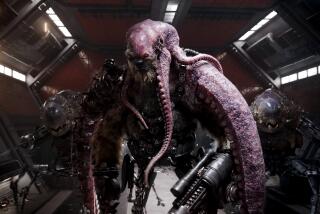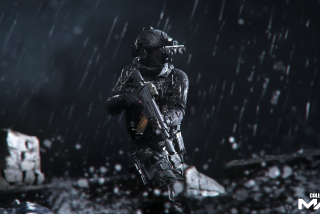Simon Atherton, prop weapons maker for movies
- Share via
Simon Atherton and his team crafted more than 900 swords, shields and other weaponry for “Clash of the Titans,” but he’s always been a pretty peaceful guy.
“I don’t really like shooting animals and things,” he said. “And even though weapons like firearms and swords are functional, there is a lot of artistic input that goes into the weapons as well. People decorate them and make them into things that are quite beautiful. So all of these crafts that come into it fascinate me -- engraving, working with wood to make the stocks and the handles for swords.”
A native of the small fishing village of Coverack in Cornwall, England, Atherton undertook a six-year apprenticeship with a gun maker when he was 16.
“I made the tea, I got the biscuits from the shop, and I did all that,” he recalled. “And then I started to work on the guns, doing very small repairs, cleaning them. And then slowly, I was allowed to make things. My apprenticeship built that way until eventually I could build the whole weapon.”
Atherton joined a company in London that created weapons for the film industry, and wound up working on 1981’s “Raiders of the Lost Ark.”
In 1997, he went out on his own, working on such films as 1998’s “Saving Private Ryan,” 2000’s “Gladiator” and the upcoming “John Carter of Mars.”
“It was just circumstances that I ended up not making guns that kill people for real,” he said.
Arachnophilia: In “Clash of the Titans,” the world’s lightest and strongest shield is made from a piece of a giant scorpion’s exoskeleton. “We created the shield before they had actually created the scorpion,” said Atherton. “We were looking at the concept drawings [of the creature], and trying to find a part of the scorpion that could be broken away and fashioned into a shield. We sculpted the shield in a Plasticine or a clay, we took a silicone mold off that and then we poured into that with high-density foam. . . . . On the back of the shield, there’s a mother of pearl effect.”
Different strokes: One sword does not fit all. “We use lots of different materials to create the sword that the person needs for the stunt or the effect that he’s going to do,” Atherton said. “If he wants to look pretty fast with the sword, it needs to be lightweight, so we’d make it from a bamboo construction. If he’s going to fall off a building, we would construct the sword in a foam or a rubber, so if he accidentally fell on it, he wouldn’t be damaged. And then sometimes, if he really has to go hell-for-leather, we’d make aluminum ones. If for some reason the sword has to cut through a prosthetic, we’d use a steel blade that’s sharpened up to do that. One sword that you see on the screen probably has six or seven different variations that are used throughout the scene.”
Olympus’ finest: Atherton had the challenge of creating one sword that, in the world of the film, was forged by Zeus. “The sword that’s given to Perseus by the gods, instead of having a double-sided blade, has a front-cutting, single-sided edge,” Atherton explained. “The shape of it evolved over lots of discussions with the director. Once we’d got the finished item, we then cast that in bronze, which looked very nice but was a bit too heavy. But for some of the hero shots and the close-ups on the sword, the bronze one was used.”
Weapons testing: Atherton works closely with the stunt department. “As we create a weapon, we start to think about how someone is going to fight with it,” he said. “The first thing we do when we build a weapon or start to get an idea of the size the director wants is we’ll run up and down stairs with it. We’ll see if we can climb on a horse with it. And that’s in its very primitive form, the shape or length that it is. And from that we can learn that we need to cut 2 inches off it, or every time we wield it, the pummel starts to hit us in the wrists. And we’ll develop it so that it functions. Then we’ll . . . . think, ‘Now it works, how can we make it look beautiful?’ ”
More to Read
Only good movies
Get the Indie Focus newsletter, Mark Olsen's weekly guide to the world of cinema.
You may occasionally receive promotional content from the Los Angeles Times.










